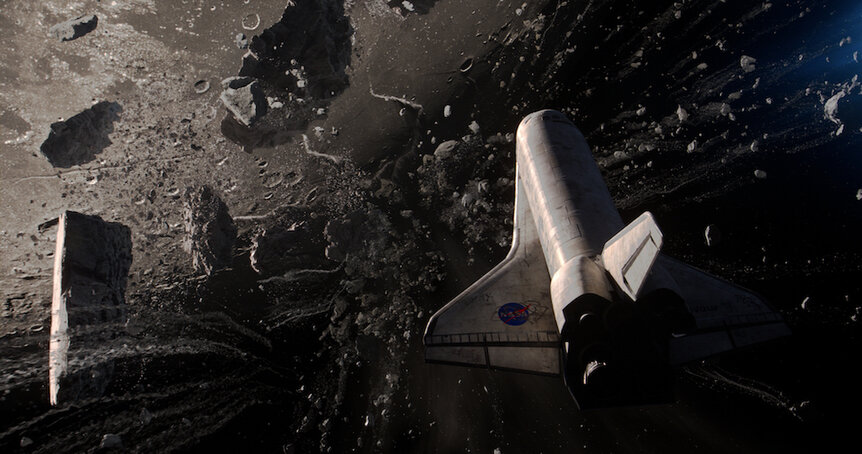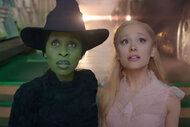Create a free profile to get unlimited access to exclusive videos, sweepstakes, and more!
What Would Happen if the Moon, Uh, Fell? The Real Science Behind Moonfall Explained
When the moon hits your eye like a big pizza pie that's... the destruction of Earth and all life.

It's been a rough couple of years and what we all need right now is an absolutely unhinged disaster flick to raise our spirits. Fortunately, we're in luck. Directed by noted end of the world enthusiast Roland Emmerich (Independence Day, The Day After Tomorrow) and starring Halle Berry, Patrick Wilson, and Game of Thrones' John Bradley, Moonfall dares to ask what might happen if the moon fell out of orbit and came hurtling toward Earth.
Despite its seemingly ridiculous premise, NASA took the time on X, the social platform previously known as Twitter to assure everyone that the moon is in a stable orbit and won't, in fact, crash into our planet. Although, skeptics might say that's exactly the sort of thing NASA would want us to believe. In any event, it is unlikely — some might even say impossible — for the moon to slide into our planetary DMs for a catastrophic cuddle sesh, but what if it did?
RELATED: How Old School Star Trek Inspired SYFY Series The Ark
How Could the Moon Fall Out of Orbit?
Before we can talk about what might happen if the moon came calling, perhaps seeking vengeance for the planetary punch that created it, we need to figure a way to make it fall.
The movie seems to suggest there's a nefarious intelligence at work which intentionally sends the moon toward the planet. We don't have an evil alien race handy for our purposes (as far as we know), so we'll have to think of something else.
RELATED: Moonfall airs on SYFY twice in upcoming days. The first airing will take place at 9:04 P.M. Monday December 11, followed by a matinee screening at 10:29 A.M. the following day. Check the complete SYFY schedule here.
It helps to understand how orbits work and what exactly keeps the moon nice and steady, right where we want it. The Hitchhiker's Guide to the Galaxy tells us that the trick to flying is an ability to throw yourself at the ground and miss. That's basically what's happening with orbits.
In truth, the moon is falling toward the Earth all the time. It's just that it's moving so quickly, laterally with respect to the Earth, that it never quite hits the surface. If you imagine throwing an object as hard and as fast you as you can, and tracing its trajectory, you'll see that the object moves away from you, while simultaneously falling toward the ground. The faster you throw something, the further it gets before it lands. Because the Earth is a sphere (no matter what the flat Earthers say), the ground is slowly sloping downward. There's a speed at which an object's forward momentum matches the curvature of the Earth. At that speed, you can keep on falling forever as long as you don't slow down.
Of course, orbits are a bit more complicated but that's basically what's happening. Gravity pulls the Earth and the moon together, but they're moving too fast to hit. That's a stable orbit. In actuality, the moon isn't in a totally stable orbit, insomuch as the speed and gravity aren't perfectly matched. But we have the opposite problem as the one presented in Moonfall, over time, the moon is getting farther from the Earth, at a rate of roughly four centimeters a year.
So, that's the trick. If you want to make the moon hit the Earth, you'll need to slow it down. If you want it to hit the Earth any time soon, you'll need to slow it down a lot.
So, We've Slowed Down the Moon and it's Falling. Now What?
It would be bad. Like, really bad. In the end, if the moon actually struck the planet, it would be an extinction like the world has never seen. The asteroid which killed the dinosaurs, along with three quarters of all the life on Earth, was only about 12 kilometers in diameter. That's big, but it's peanuts to the moon with a diameter of about 3,500 kilometers. If the moon and the Earth actually collided, everything would be dead. More than that, any hint that anything had ever existed here at all would be erased. But, that wouldn't happen, because of the Roche limit.
The Roche limit is a point between any two gravitationally bound objects where the tidal forces overwhelm the gravity holding things together. In simpler terms, if the moon were to get within about 11,500 miles above the planet's surface, gravity from the Earth would be stronger than the gravity binding it and it would break apart.
The pieces of the moon would scatter to form a vast ring system, not unlike the rings of Saturn, 23,000 miles across. It would be pretty for a minute, but those chunks would eventually rain down on the planet, starting with the smaller ones and ending with the biggest.
The Earth would be at the mercy of a non-stop barrage of moon rocks impacting the surface. Even if they were small enough to burn up in the atmosphere, the thermal energy would heat up the climate to an unlivable degree. There's really no scenario in which the moon gets significantly close to the Earth which ends well for us.
Listen moon, we want to hang out with you, really. But we'll come to your house, don't come to ours.
In the meantime, you can Moonfall airing on SYFY twice in upcoming days. The first airing will take place at 9:04 P.M. Monday December 11, followed by a matinee screening at 10:29 A.M. the following day. Check the complete SYFY schedule for all your science fiction movie needs.
Trending News
Originally published Feb 2, 2022.















